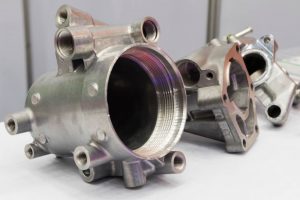Aluminum is a metal that is silvery white in color. It is the 13th element in the periodic table and is the most widespread metal available on Earth.
It is known for being one of the lightest metals in the world, extremely flexible and strong. It is also a metal that forms alloys with many other metals. It can be easily processed with pressure when it is hot and cold, making it a suitable metal for die casting.
Table of Contents
What is aluminum die casting?
Aluminum die casting is a manufacturing process where aluminum or aluminum alloys are molted under high pressure. The metals are hardened into the desired shape and are produced in high quantities. Precision die casting for aluminum can be carried out with both hot chamber die casting and cold chamber die casting processes, but cold chamber machines are usually used due to its high melting point.
Why is aluminum used in die casting?
Aluminum is a metal that is used in die casting because of its unique properties. It is low density, non toxic and also has high thermal conductivity. It is also a metal that can easily be cast, machined and formed into all sorts of shapes.
It is also a top choice for die casting because it is malleable and ductile. Additionally, many manufacturers opt for aluminum because it is cost effective and recyclable.
Aluminum die casting process
The aluminum die casting process is one that is relatively simple. A steel mold is used to produce a big quantity of castings in a very short amount of time.
- The casting process starts with the two die halves being clamped together tightly with a die casting press. These sections are fixed securely and are arranged in such a way so that one half is stationary while the other half is movable.
- Molten aluminum is then injected into the die cavity created by the two die halves. The molten aluminum solidifies quickly. The die halves are then drawn apart and the solidified casting is ejected.
Most aluminum die casting machines utilize hydraulic cylinders or direct acting hydraulic pressure. Die casting dies can be both simple or complex, depending on the product that is to be manufactured. The dies can also have movable slides, cores as well as other sections, again depending on the complexity of the product.
While aluminum die casting machines can vary in size, they usually work according to the basic process of injecting molten metal into the die to create the casting.
Advantages of aluminum die casting
Aluminum is one of the most common non-ferrous die casted metal in the world. And it comes as no surprise since aluminum die casting has plenty of advantages including:
- It is a lightweight metal that enables the creation of lightweight parts without compromising on strength.
- It can withstand high operating temperatures.
- There are more surface finishing options available for aluminum as compared to many metals.
- Durable and corrosion resistant.
- Highly conductive.
- Excellent strength to weight ratio.
- A high volume of die casted parts can be produced quickly.
- It is cost effective.
- Fully recyclable and reusable in production.
Aluminum die casting applications
Aluminum die casting has an incredible number of applications in numerous industries around the world.
It is used because of its distinctive features such as being lightweight and corrosion resistant. Its high stability and high electrical and thermal conductivity are also other reasons why aluminum die cast products are so popular.
It is widely used in the following sectors and industries:
- Transportation – Aluminum automotive die casting has played a part in the replacement of iron and steel components in vehicles to increase fuel efficiency. This will only continue as there is increasing demand for fuel-efficient vehicles globally as consumers become more concerned about their impact on the environment.
- Electronic connectors and housings – Aluminum die cast products are popular in this sector as it has good electrical performance as well as shielding properties. This feature can be seen even in high temperatures.
- Building and construction – There is a high demand for aluminum die casting especially in developing nations in the Asia Pacific region. The Asia Pacific accounts for over half the shares in the global aluminum casting market and the growth is expected to continue. It is used in the creation for shop partitions, fittings, cladding, windows, curtain walling and also prefabricated buildings, among others.
- Aerospace – As the aerospace industry continues to grow, there is demand to produce air-frame components at a lower cost and larger quantity.
- Handheld devices – Aluminum castings light and are able to provide EMI/RFI shielding and durability which is suitable for handheld devices.
Conclusion
Aluminum die casting is a process that is used to manufacture many products. The unique advantages of aluminum die cast products mean that it is popular in many fields and industries.
The article is a part of our comprehensive guide on “Die casting: Process, Equipment, Uses, and More”
If you are looking to produce an aluminum die cast product, check out EKO Industries and the services that they provide.



